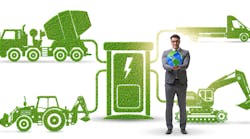In August, Navistar revealed its new International S13 Integrated Powertrain. During a press conference in Las Vegas, the company indicated this is the final internal combustion engine it will manufacture as the industry transitions to zero emissions. Navistar CEO Mathias Carlbaum said the engine “is a major milestone in our journey to zero-emissions transportation."
In April, Cummins unveiled a fuel-agnostic internal combustion powertrain that operates on lower carbon fuel types. In announcing the engine, the president of Cummins' engine business, Srikanth Padmanabhan, said, “Getting to zero is not a light-switch event. Carbon emissions that we put into the atmosphere today will have a lasting impact. This means anything we can do to start reducing the carbon footprint today is a win for the planet. We need to take action now.”
See also: Navistar comes ‘full circle’ with new powertrain
There are many other examples of major truck makers talking about their efforts to make their vehicles cleaner and greener. And if that is not enough to convince you that trucking is moving toward zero emissions, look at the new companies that have jumped into the trucking sector offering battery-electric alternatives—BYD, Lightning eMotors, Lion, Lonestar SV, Motiv, Orange EV, Nikola, Shyft Group, and Tesla, to name a few.
While the path to zero emissions has a long way to go, that does not mean you should sit around and wait until every problem is ironed out. There are applications today for which alternative-fueled vehicles in general and battery-electric vehicles (BEVs) specifically make sense and are viable options.
If you are operating one-shift, short-haul, return-to-base duty cycles, you’ll find that BEVs are a good fit. Drivers can complete their routes and bring the trucks back to the distribution facility to charge overnight. There are other applications like step vans in parcel delivery, medium-duty box trucks, terminal tractors, and even some heavy-duty regional haul applications where BEVs are being successfully deployed.
See also: Cummins is finding more than one way to decarbonize fleets
When people talk about BEVs, they tend to focus on the lack of charging infrastructure, ignoring the fact that a significant segment of the trucking industry has trucks that don’t rack up a huge number of miles per day, so the vehicles will not need to charge during their normal course of operation. Manufacturers and independents are working hard to install charging infrastructure. Daimler Truck North America, NextEra Energy Resources, and BlackRock Renewable Power all have viable solutions and are installing stations today.
Work is being done to move trucking away from diesel toward zero-emissions powertrain options. To be clear, this transition will not happen overnight. But it will happen, especially given the fact that many states have set zero-emissions sales goals for heavy trucks from 2030 to 2050.
Consider how you can plan for a zero-emissions future that is right for your operations. Meet with BEV manufacturers, local utilities, and other fleets that are already using BEVs successfully to see how BEVs can fit in your operation.
Patrick Gaskins, SVP of Corcentric Fleet Solutions, oversees both sales and operations for the company's fleet offerings. Gaskins joined the company in 2010, bringing more than 30 years of experience as a financial services professional in the transportation industry. He leads a team that works with a supply base of more than 160 manufacturers to help the country’s largest fleets manage all aspects of their fleet operations and fleet-related spend.




